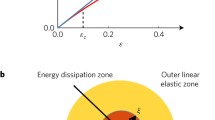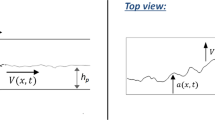Abstract
Tunneling cracks driven by drying in a ceramic precursor confined between two glass plates represent a simple type of three-dimensional (3D) crack pattern. They arrange themselves via mutual unloading which causes some cracks to stop whereby the remaining ones get the right spacing for further propagation. By extending a 2D-model of self-driven propagation of crack arrays, a fracture mechanical bifurcation analysis for 3D-crack patterns based on calculating the post-critical contour of the alternating bifurcation mode has been developed. Shrinkage due to drying is replaced here by a simplified thermo-mechanical model based on an effective heat flow whose related temperature field and thermal stresses drive crack propagation. By means of the finite element method, the propagation velocity and the minimum spacing between the steady-state parallel tunnelling cracks are determined. Comparison of theory and experiment suggests that propagation may be non-stationary in these experiments. The observed relation between crack spacing and layer thickness, p ~ e 2/3, follows from a scaling analysis.
Similar content being viewed by others
References
Allain C, Limat L (1995) Regular patterns of cracks formed by directional drying of a colloidial suspension. Phys Rev E 74(15): 2981–2985
ANSYS (2004) User’s manual (version 9.0). Swanson Analysis Systems Inc.
Bahr H-A, Bahr U, Gerbatsch A, Pflugbeil I, Voitja A Weiss H-J (1995) Fracture mechanical analysis of morphological transitions in thermal shock cracking. Fract Mech Ceram 11/12:507–522
Bahr H-A, Bahr U, Petzold A (1992) 1-D deterministic crack pattern formation as a growth process with restrictions. Europhys Lett 19(6):485–490
Bahr H-A, Weiss H-J, Bahr U, Hofmann M, Balke H (in preparation) Thermal shock crack patterns, tunnelling cracks and basalt columns: Scaling of driven crack
Bazant ZP, Ohtsubo H, Aoh K (1979) Stability and post-critical growth of a system of cooling or shrinkage cracks. Int J Fract 15:443–456
Boeck T, Bahr H-A, Lampenscherf S, Bahr U (1999) Self-driven propagation of crack arrays: a stationary two-dimensional model. Phys Rev 59(2):1408–1415
Budkewitsch P, Robin P-Y (1994) Modelling the evolution of columnar joints. J Volcanol Geotherm Res 59:219–239
DeGraff JM, Aydin A (1993) Effect of thermal regime on growth increment and spacing of contraction joints in basaltic lava. J Geophys Res 98:6411–6430
Gille G (1985) Strength of thin films and coatings. Curr Top Mater Sci 12:420–472
Goehring L, Morris SW (2005) Order and disorder in columnar joints. Europhys Lett 69:739–745
Ho S, Suo Z (1993) Tunneling cracks in constrained layers. Tran ASME 60:890–894
Hull D, Caddock BD (1999) Simulation of prismatic cracking of cooling basalt lava flows by the drying of sol-gels. J Mater Sci 34:5707–5720
Hutchinson JW, Suo Z (1992) Mixed mode cracking in layered materials. Adv Appl Mech 29:63–191
Hwang CG, Wawrzynek PA, Ingraffea AR (2001) On the virtual crack extension method for calculation the derivatives of energy release rates for a 3D planar crack of arbitrary shape under mode I loading. Eng Fract Mech 68:925–947
Komatsu TS, Sasa S (1997) Pattern selection of cracks in directionally drying fracture. Jpn J Appl Phys 36:391–395
Müller G (1998) Experimental simulation of basalt columns. J Volcanol Geother Res 86:93–96
Nemat-Nasser S, Sumi Y, Keer LM (1980) Unstable growth of tension cracks in brittle solids: stable and unstable bifurcation, snap through, and imperfection sensitivity. Int J Solids Struct 16:1017–1035
Author information
Authors and Affiliations
Corresponding author
Rights and permissions
About this article
Cite this article
Hofmann, M., Bahr, H.A., Linse, T. et al. Self-driven tunneling crack arrays—a 3D-fracture mechanics bifurcation analysis. Int J Fract 141, 345–356 (2006). https://doi.org/10.1007/s10704-006-9001-1
Received:
Accepted:
Published:
Issue Date:
DOI: https://doi.org/10.1007/s10704-006-9001-1




